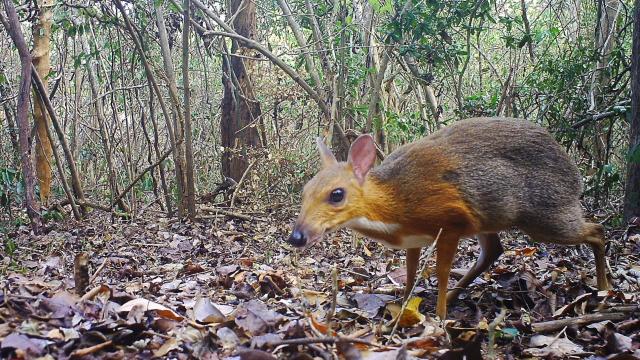Using dozens of motion-activated camera traps, conservationists in Vietnam have captured photographic evidence of the silver-backed chevrotain—an impossibly adorable deer-like creature that hadn’t been seen since 1990.
“In an age of mass extinctions, confirming the survival of lost species provides rare second chances for biodiversity conservation,” opens a new research article published today in Nature Ecology & Evolution.
No doubt, this is exciting news, as scientists weren’t sure if the silver-backed chevrotain (Tragulus versicolor), a tiny deer-like ungulate, was extinct or not. The scientists who led the study, a team from Global Wildlife Conservation in Austin, the Leibniz Institute for Zoo and Wildlife Research in Berlin, and other institutions, are now urging for immediate conservation efforts to ensure the ongoing survival of this little hoofed mammal.
Writing to Gizmodo in an email, Andrew Tilker, a PhD student at the Leibniz Institute and a co-author of the new study, said his team “had no reason” to believe the species might be extinct, “simply because it appears that no one had really looked for it,” but “we didn’t completely discount the possibility that the species had gone extinct, either.”
That the silver-backed chevrotain had gone the way of the dodo was a distinct possibility, as poaching is rampant in the heavily forested Annamites region of Vietnam where these animals live. The high frequency of hunting and wire snares in the area has resulted in what conservationists call “empty forest syndrome.” In a potentially grim portent, the last confirmed sighting of the silver-backed chevrotain was of a specimen killed by a hunter in 1990.
“We had so little information on the species that we didn’t have a pre-formed idea of whether or not it was still out there, or if it did still exist, how difficult it would be to find it,” Tilker told Gizmodo. “We just didn’t know.”
For the project, Tilker and his colleagues interviewed local people in three Vietnamese provinces to find out if they had seen animals bearing the description of the silver-backed chevrotain—a species that bears a striking resemblance to the widespread lesser chevrotain (Tragulus kanchil), also known as the kanchil or lesser Malay chevrotain. Both species are tiny, standing around 18 inches (45 centimeters) tall, but the silver-backed chevrotain has two-tone coloration and grey hairs tipped with white, among other distinguishing features.
Using the information gleaned from the locals, the scientists distributed nearly 30 motion-activated camera traps in places deemed most likely to host these elusive creatures. Over the course of six months, the traps chronicled 208 independent detections of the silver-backed chevrotain, with 15 out of the 29 stations recording sightings. The animals were spotted primarily during the day, appearing solo 97 per cent of the time and with a partner 3 per cent of the time.
Tilker said he was “thrilled” by the results, but the “moment of elation” was short-lived due to the reality of the situation.
“Soon I started thinking about the gazillion questions that we needed to follow up on if we were to try to protect the species,” he said. “How threatened was the silver-backed chevrotain? To what extent had it declined from snaring? Was this the only population or could there be others?”
The researchers couldn’t determine the overall population size due to insufficient data, but these animals appear to be abundant in the single area surveyed.
“Of course, this is very encouraging,” Tilker told Gizmodo. “However, we must be careful here not to jump to conclusions—just because the species appears to be locally abundant in one area does not necessarily mean that it is abundant in other parts of its range. To assess the conservation status of the species, we need more information.”
Looking ahead, Tilker said immediate efforts are needed to protect this single known population, along with more surveys to better determine the overall population size and an assessment of its most imminent threats.
“It is almost certain that populations of silver-backed chevrotain have been impacted by snaring,” said Tilker. “Reducing snaring pressure will therefore be an important part of ensuring its survival. That, in itself, is a complex undertaking, which will likely include reducing demand for wildlife products, strengthening enforcement in protected areas, and awareness-raising among the general public.”
Losing the silver-backed chevrotain to extinction would be a big loss. Like all ungulates, this species likely helps to distribute seeds, which contributes to the overall health of tropical forests. As the authors noted in the study, the rediscovery of the species now represents a rare second chance that hopefully won’t be squandered.
